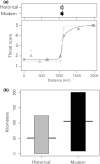Temporal stability of the hybrid zone between Calocitta magpie-jays revealed through comparison of museum specimens and iNaturalist photos
- PMID: 36937059
- PMCID: PMC10017314
- DOI: 10.1002/ece3.9863
Temporal stability of the hybrid zone between Calocitta magpie-jays revealed through comparison of museum specimens and iNaturalist photos
Abstract
Hybrid zones are natural experiments for the study of avian evolution. Hybrid zones can be dynamic, moving as species adjust to new climates and habitats, with unknown implications for species and speciation. There are relatively few studies that have comparable modern and historic sampling to assess change in hybrid zone location and width over time, and those studies have generally found mixed results, with many hybrid zones showing change over time, but others showing stability. The white-throated magpie-jay (Calocitta formosa) and black-throated magpie-jay (Calocitta colliei) occur along the western coast of Mexico and Central America. The two species differ markedly in throat color and tail length, and prior observation suggests a narrow hybrid zone in southern Jalisco where individuals have mixed throat color. This study aims to assess the existence and temporal stability of this putative hybrid zone by comparing throat color between georeferenced historical museum specimens and modern photos from iNaturalist with precise locality information. Our results confirm the existence of a narrow hybrid zone in Jalisco, with modern throat scores gradually increasing from the parental ends of the cline toward the cline center in a sigmoidal curve characteristic of hybrid zones. Our temporal comparison suggests that the hybrid zone has not shifted its position between historical (pre-1973) and modern (post-2005) time periods-a surprising result given the grand scale of habitat change to the western Mexican lowlands during this time. An anomalous pocket of white-throated individuals in the northern range of the black-throated magpie-jay hints at the possibility of prehistorical long-distance introduction. Future genomic data will help disentangle the evolutionary history of these lineages and better characterize how secondary contact is affecting both the DNA and the phenotype of these species.
Keywords: birds; gene flow; global change; habitat change; introgression.
© 2023 The Authors. Ecology and Evolution published by John Wiley & Sons Ltd.
Conflict of interest statement
The authors declare no competing interests.
Figures


Similar articles
-
Hybrid zone or hybrid lineage: a genomic reevaluation of Sibley's classic species conundrum in Pipilo towhees.Evolution. 2023 Mar 1;77(3):852-869. doi: 10.1093/evolut/qpac068. Evolution. 2023. PMID: 36626801
-
Cross-decades stability of an avian hybrid zone.J Evol Biol. 2019 Nov;32(11):1242-1251. doi: 10.1111/jeb.13524. Epub 2019 Oct 3. J Evol Biol. 2019. PMID: 31430391
-
Genetic and phenotypic characterization of a hybrid zone between polyandrous Northern and Wattled Jacanas in Western Panama.BMC Evol Biol. 2014 Nov 15;14:227. doi: 10.1186/s12862-014-0227-7. BMC Evol Biol. 2014. PMID: 25394718 Free PMC article.
-
Insights into Aotearoa New Zealand's biogeographic history provided by the study of natural hybrid zones.J R Soc N Z. 2022 Apr 11;54(1):55-74. doi: 10.1080/03036758.2022.2061020. eCollection 2024. J R Soc N Z. 2022. PMID: 39439473 Free PMC article. Review.
-
Empirical study of hybrid zone movement.Heredity (Edinb). 2007 Sep;99(3):301-12. doi: 10.1038/sj.hdy.6800997. Epub 2007 Jul 4. Heredity (Edinb). 2007. PMID: 17611495 Review.
Cited by
-
Environmental colour pattern variation in Mediterranean Podarcis.BMC Ecol Evol. 2024 Apr 25;24(1):53. doi: 10.1186/s12862-024-02242-1. BMC Ecol Evol. 2024. PMID: 38658833 Free PMC article.
-
Trait Variation and Spatiotemporal Dynamics across Avian Secondary Contact Zones.Biology (Basel). 2024 Aug 22;13(8):643. doi: 10.3390/biology13080643. Biology (Basel). 2024. PMID: 39194581 Free PMC article. Review.
References
-
- Aguillon, S. M. , & Rohwer, V. G. (2022). Revisiting a classic hybrid zone: Movement of the northern flicker hybrid zone in contemporary times. Evolution, 76, 1082–1090. - PubMed
-
- Aguillon, S. M. , & Shultz, A. J. (2022). Community‐sourced sightings of atypical birds can be used to understand the evolution of plumage color and pattern. EcoEvoArxiv. 10.32942/osf.io/fhkev - DOI
-
- Amador, É. , Mendoza Salgado, R. A. , Ramírez Rosas, J. J. , & Palacios, E. (2009). First formal record of the Black‐throated Magpie‐Jay (Calocitta colliei) from Baja California Sur, Mexico. Huitzil, 10, 22–23.
LinkOut - more resources
Full Text Sources

